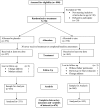Randomized trial of the effect of zinc supplementation on the mental health of school-age children in Guatemala
- PMID: 20881069
- PMCID: PMC2954453
- DOI: 10.3945/ajcn.2010.29686
Randomized trial of the effect of zinc supplementation on the mental health of school-age children in Guatemala
Abstract
Background: Rates of mental illness in children are increasing throughout the world. Observational studies of depression, anxiety, and attention-deficit hyperactivity disorder suggest that zinc is an alternative treatment.
Objective: We examined the effect of zinc supplementation on the mental health of school-age children in Guatemala.
Design: From January to October 2006, we conducted a 6-mo randomized, double-blind, controlled trial comparing zinc supplementation (10 mg ZnO/d for 5 d/wk) with a placebo (10 mg glucose) in 674 Guatemalan children in grades 1-4. Outcome measures included internalizing (ie, depression and anxiety) and externalizing (ie, hyperactivity and conduct disorder) problem behaviors, positive behaviors (ie, socialization and leadership), and serum zinc concentrations.
Results: Zinc and placebo groups did not differ significantly in any behavioral measures at baseline or at follow-up. At baseline, 21.4% of children had serum zinc concentrations <65 μg/dL. At follow-up, both groups improved significantly, and zinc concentrations were higher in the zinc group. Increases in serum zinc concentrations were inversely associated with decreases in depressive symptoms (estimate: -0.01 points per μg Zn/dL; P = 0.01), anxiety (estimate: -0.012 points per μg Zn/dL; P = 0.02), internalizing symptoms (estimate: -0.021 points per μg Zn/dL; P = 0.02), and social skills (estimate: -0.019 points per μg Zn/dL; P = 0.01) in adjusted models that were controlled for child age, sex, socioeconomic status, household, and treatment group.
Conclusions: Six months of zinc supplementation did not induce differences in mental health outcomes between zinc and placebo groups. However, increases in serum zinc concentrations were associated with decreases in internalizing symptoms (ie, depression and anxiety) in a community-based sample of children at risk of zinc deficiency. This trial was registered at clinicaltrials.gov as NCT00283660.
Figures
References
-
- Belfer ML, Saxena S. WHO Child Atlas project. Lancet 2006;367:551–2 - PubMed
-
- World Health Organization The World Health Report 2001: mental health: new understanding, new hope. Geneva, Switzerland: World Health Organization, 2001
-
- US Public Health Service Report of the Surgeon General's conference on children's mental health: a national action agenda. Washington, DC: US Department of Health and Human Services, 2000 - PubMed
-
- The National Advisory Mental Health Council Workgroup on Child and Adolescent Mental Health Intervention Development and Deployment Blueprint for change: research on child and adolescent mental health. Washington, DC: National Institute of Mental Health, 2001
-
- Burns BJ, Costello EJ, Angold A, et al. Children's mental health service use across service sectors. Health Aff (Millwood) 1995;14:147–59 - PubMed
Publication types
MeSH terms
Substances
Associated data
Grants and funding
LinkOut - more resources
Full Text Sources
Medical


